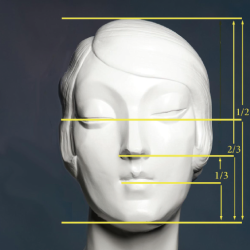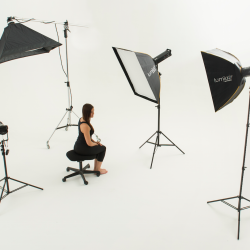Taking a Beautiful Portrait- Understanding Facial Analysis, Lighting, Angle, and Lens Selection
What do we want and what do our clients want? When taking a portrait, the concern is whether a portrait should be an exact, idealized, or factually correct portrayal of the subject. In photographic portraits, we have the ability to make this choice in sophisticated ways. We cannot deny that our subjects want to look their best, but this is not the same as looking perfect. It is not only an issue of retouching, but also of making proper choices in lighting and composing the portrait. We have the ability to fine-tune a portrait while recognizing the differences that make our subjects individuals. For the portrait photographer, facial analysis is of primary importance. The principles of facial analysis described below can help capture the true persona of our subjects.
Analyzing the Face
Basic Head Proportions. There are five planes that determine lighting patterns on the face. These are part of our consideration as we analyze the face, for it is the patterns of light and dark that give the face the desired form, volume, and qualities. We look for deviations from a “normal” face, with normal defined as head proportions with the eyes halfway from the top of the skull to the chin, the nose approximately one third of the way from the eyes to the chin, and the mouth approximately two-thirds of the way from the eyes to the bottom of the chin. These basic proportions are roughly common to all face shapes, though individual and ethnic variations occur.
The Nose. An important facial plane for determining portrait lighting is the nose, and therefore it is important to analyze how the nose will be seen and how it will cast shadows. The nose’s length is approximately half the length of distance between the top of the forehead, the hairline (unless receded), and the chin. Its width tends to be proportional to the width of the face, i.e., roughly one-third the width of the face. However, the shape of the nose is most important and often dictates the pose; for example, with a large nose, a profile is less flattering.
The Eyes. The eyes are often seen as the key to the inner portrait. Therefore, their structure is important to the analysis of the face. Their shape and depth in the face, along with the brow shape and weight, define the structure of the eyes. Eye shape is primarily a genetic factor based on heritage and ethnicity. For the most part, the eyes are approximately equal in size; unless there are large flaws in their shapes, the eyes will be active in the portrait but will not demand any substantive correction. Far more important in facial analysis are the depth of the eyes, the angularity of the brow, and the height of the cheekbones.
The Mouth and Jaw. The lower portion of the face, from the nose to the chin, needs to be considered as well. The lips, particularly for women, are both well defined and adjustable. Using lipstick, the shape of the lips can be strengthened or weakened for the purposes of the portrait. Below the lips, the structure of the chin plays a major role in defining facial structure. As mentioned earlier, the shape of the jaw establishes other factors of the face. When the jaw is narrow and angular, the face tends toward either a triangular or long shape that is seen as weak. A square jaw tends to be seen as stronger. The chin and its form add to the jaw’s strength when extended out from the face and, conversely, add to the jaw’s weakness when subtle, rounded, or flat.

Additional Points to Consider
The Right Lighting. Once we have determined the basic structure of the face, we can establish the best lighting and pose. Here we can benefit from the way beauticians apply makeup to their clients. The use of lighting based on facial analysis is often called corrective action, but it is as much an issue of correct posing as it is of fixing flaws.
The Perfect Angle. Perhaps the easiest choice to make based on facial analysis is the relationship of the facial axis and the camera axis. While short or broad lighting is the primary method of determining the width of the face, rotating the face away from the camera introduces foreshortening and tends to thin the face. This aspect of posing based on facial analysis is effective until the face is rotated to about a 45-degree angle with the camera axis. Beyond this point the facial shape is less important as the profile takes precedence. Narrowing the view of the face with rotation is beneficial when the breadth of the face needs to be reduced, and the effect can be enhanced further by using short, higher-ratio lighting. The result is shadowing on part of the camera-facing portion of the subject’s head, which diminishes its size. With a broad face, a higher angled key light also increases shadowing and reduces the face’s perceived width. It is common to use a slightly higher camera position in relation to the subject.
Proper Lens Choice. Lens choice is also important in facial interpretation. Shorter than normal lenses (e.g., a 50mm on a full frame 35mm DSLR camera) tend to increase roundness but introduce an unpleasant distortion. Most portrait artists favor longer than normal (telephoto) lenses. They flatten perspective and produce what is perceived as a more pleasing appearance. You can learn more about selecting the right lens from The Lens by NK Guy.
These tips were taken from The Portrait, 2nd Edition. Curious about Portrait Photography? Check out The Portrait by Glenn Rand and Tim Meyer.

